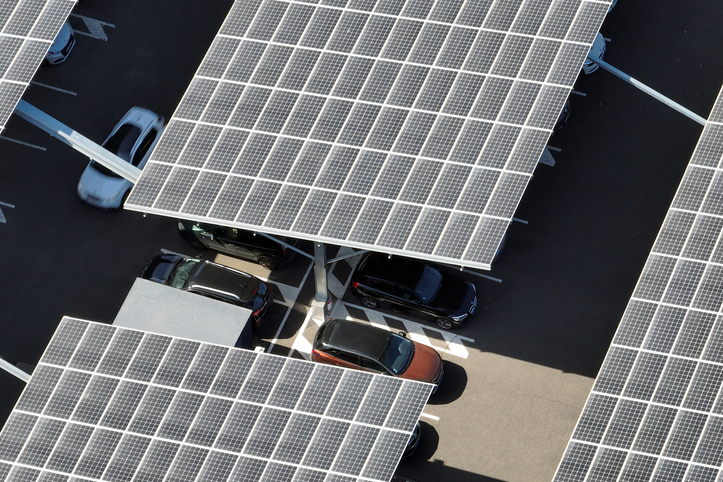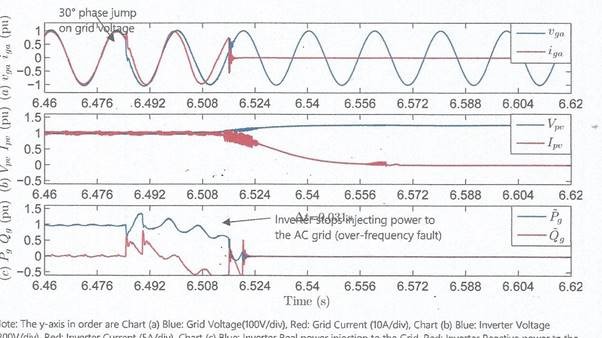Enabling the vehicle-to-grid innovation with the latest draft Standard

Aerial view of solar panels installed as shade roof over parking lot with parked cars for effective generation of clean electricity. Photovoltaic technology integrated in urban infrastructure.
We’re merely scratching the surface of what EVs can do for the home with V2G, V2H and V2L capabilities around the corner. Phil Kreveld looks into the technology to find out what electricians need to be aware of.
The new draft specification for solar inverter installations, DR AS/NZS 4777.1:2022 Grid connection of energy systems via inverters, Part 1: Installation requirements, represents a major shift in the Australian electrical energy generation landscape. As Australia becomes ‘electrified’ and transitions to a more energy-efficient future, there are questions about how our power grids will deal with all the required energy.
This draft Standard counts on vehicle-to-grid (V2G), vehicle-to-home (V2H) and vehicle-to-load (V2L), on top of other grid support functions, to help ease the load on the grid. The idea is that our electric vehicles (EVs) can help power our houses when they’re charging, being used as a pseudo-backup generator.
ADVERTISEMENT
Imagine you’re coming home after work on one of Australia’s hotter days. Maybe you’ve picked up the kids from school as well and as soon as you walk in the door, the first thing you’d want to do is flick on the air conditioning. Since you’ve finished work, there’s a chance you’ll want to get dinner ready as soon as possible so you can sit back and relax as soon as possible so you flick on the oven for a nice roast.
All of these activities are completely expected but also electrically exhaustive and the electrical grid has been dealing with it for decades. As more Australians start driving EVs, there’s another step in that coming home process that sucks up a lot of energy as well (depending on the charger installation and time of charge).
With so much potential pressure on the electrical grid, energy operators are keen to look at other ways to power homes and with V2G and other associated technologies, there’s a chance that everyone will have an answer to grid stress: their vehicles.
The current Standard, AS/NZS 4777.2 governs the requirements for grid-connected inverters. At the time of writing, DR AS/NZS 4777.1:2022 has just completed its public comment phase and is in the process of becoming a new Standard. It’s a really big deal for the solar industry and is going to be a key element in enabling V2G in Australia and if electricians are working with V2G products, solutions or installations in the next three to five years in Australia, it’s worth a perusal.
The various changes are outlined in a new part of the Draft Standard; Part 5 ‘Multiple mode IES (Inverter Energy Source) installation’. There are two new inverter functions listed in addition to grid support; namely supplementary and alternative supply. The former refers to an inverter in its function of grid support while the latter function refers to an island supply (i.e., not connected to the supply for the installation) and could include power for workshop tools, although the Draft Standard is careful to point out that the use of an AC socket on an EV to power workshop equipment is nor captured by the Draft Standard.
The issue of the draft specification appears to be in step with the Australian Energy Market Operator’s (AEMO) draft 2024 Integrated Systems Plan which mentions virtual power plant grid support from EV batteries.
As shown in the ISP’s projections, rooftop solar and other distributed solar of 70GW capacity make up the biggest slice of a total capacity of 290GW by 2050. Given that only 15% of total capacity is needed for a projected annual energy consumption of 400TWh, large swings in electrical power can be expected. Therefore, grid stabilisation from virtual power plants including those deriving power from EV batteries, is seen to be necessary and that sees to new requirements for the operation of inverters.
The Draft Standard contemplates the increase in home energy management systems (HEMS). HEMS considers such problems as voltage control in networks under reverse power flow. For example, rather than curtailing the output of an inverter, it’s instead used to charge a battery if there is excess solar power available. This technology makes use of inverters which can also function as rectifiers, so a better term for such a device is that of converter (AC to DC and DC to AC).
Part 5 of the Draft Standard outlines the following schemes of operation in addition to the single output inverter:
- Multiple mode inverter with grid connection and alternative supply connection,
- Island supply inverter and supplementary supply inverter,
- Portable or vehicle-installed inverter, for example, AC output of an EV.
In addition to vehicle batteries as a source of energy, the draft standard also includes “secondary” inverter energy contributions from unspecified energy sources. At present, the V2G, V2H and V2L capabilities aren’t uniformly available in the following EVs:
- MG ZS (V2L)
- BYD Atto, Dolphin and Seal (V2L)
- Hyundai IONIQ 5 (V2L)
- Kia EV 6, 9 and Niro (V2L)
- Genesis GV60, GV70 and GV80 (V2L)
- Nissan LEAF (V2H, V2G)
- CUPRA Born (V2H, V2G)
- Mitsubishi Outlander, Eclipse Cross (V2G, V2H, V2L)
However, as has been stressed by the submission of the Electric Vehicle Council (EVC) to the DR AS/NZS 4777, there is a question regarding the influence that Australian Standards might exert on imported technology incorporated in EVs.
As the EVC writes in its Comment to proposal P-000142 to amend AS/NZS4777.2:2020 in 2022: “There is reason to believe that if V2G is enabled, it will also lead to faster uptake of EVs, through the ability for consumers to engage in arbitrage to their financial benefit.
“If we posit that the consumer with an EV is able to export from the vehicle to the grid at 7kW between 6pm to 9pm on most days, with a FiT of 35c/kWh, and can then recharge between midnight and 6am at 10c/kWh, the annual financial benefit to the consumer is on the order of $1,500 and $2,000.
“This benefit is additive to the benefits available to consumers through responding to price signals to charge their vehicle outside of peak times, which amount to $500-$1,000/annum/vehicle. There is future scope for FCAS or other CER-related benefits to stack with the arbitrage opportunity.”
Some issues have relevance for AS/NZS 4777.2 and can affect the operations of inverters in grid support. For example, grid stability requires an inverter that can lock onto the grid voltage even when phase jumps occur.
As the diagram (Figure 2) shows a phase jump of 30°, caused the inverter under test to lose synchronicity and cease output. Vehicles with V2G capability may or may not comply with the AS/NZS 4777.2. Equally, voltage jumps and high and low voltage limits as shown in Table 3.1 of the Draft Standard will not necessarily be complied with in vehicles with bi-directional converters (rectifier-inverter). The circuitry for this type of EV supply equipment differs greatly from standard inverters and is illustrated in Figure 3.
For the renewable transition, the stability behaviour of distribution networks is of increasing importance. At present AEMO doesn’t have effective load modelling of substations and this adds to the importance of inverters complying with new standards needed for aiding network stability. EVs, given projected rates of adoption, are likely to be a small part in terms of providing grid support. On the other hand, households with solar and batteries will constitute the bulk of grid stability support.
Australia is in pole position when it comes to the adoption of distributed generation solar so the question arises whether the AS/NZS 4777 draft follows IEC specifications.
For grid-supporting tasks, inverters are required to use phase-locked loop (PLL) synchronisation. For alternate supply, inverters require an internal oscillator for the pulse width modulation to provide an AC voltage waveform. This may be a point of confusion: all inverters in distributed generation are voltage-sourced, whether from solar panels or batteries. PLL takes care of grid support, and basically, inverters act as current sources, virtually independent of the line voltage at their terminals. Multimode inverters are equipped with PLL and an internal oscillator. Although a somewhat academic point, they shouldn’t be referred to as voltage forming as that implies the availability of droop control for output power control.
The draft DR AS 4777.1:2024 standard comes at a critical time in Australia’s transition to renewables because of increasing reliance on grid support from distribution network installed inverters, for example, AEMO’s fast frequency control ancillary service and virtual private power plant. A final comment on the Draft Standard has closed and contractors should become familiar with the proposed changes when an eventual Standard is published. There are still questions about how Australia’s grid is going to manage all the incoming power but electricians are at the forefront of enabling a range of solutions and it’s an exciting time to be on the tools.
Note: The Draft Standard DR AS/NZS 4777.2 is subject to change so there’s a chance some of the details in this article are changed by the time of print.
-
ADVERTISEMENT
-
ADVERTISEMENT




